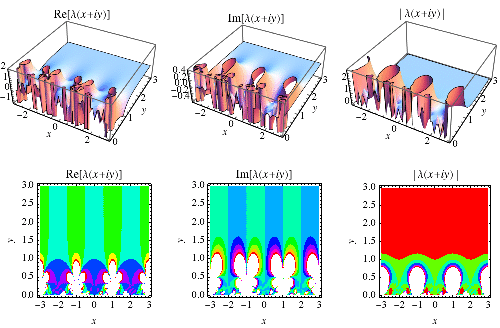 |
The elliptic lambda function is a
-modular function
defined on the upper half-plane by
 |
(1)
|
where
is the half-period ratio,
is the nome
|
(2)
|
and
are Jacobi theta functions.
The elliptic lambda function is essentially the same as the inverse nome, the difference being that elliptic lambda function is a function of the
half-period ratio , while the inverse nome
is a function of the nome
, where
is itself a function of
.
It is implemented as the Wolfram Language function ModularLambda[tau].
The elliptic lambda function satisfies the functional equations
|
(3)
| |||
|
(4)
|
has the series expansion
|
(5)
|
(OEIS A115977), and has the series expansion
|
(6)
|
(OEIS A029845; Conway and Norton 1979; Borwein and Borwein 1987, p. 117).
gives the value of the elliptic modulus
for which the complementary
and normal complete
elliptic integrals of the first kind
are related by
|
(7)
|
i.e., the elliptic integral singular value for .
It can be computed from
 |
(8)
|
where
|
(9)
|
and
is a Jacobi theta function.
is related to
by
|
(10)
|
For all rational ,
and
are known as elliptic
integral singular values, and can be expressed in terms of a finite number of
gamma functions (Selberg and Chowla 1967). Values
of
for small
include
|
(11)
| |||
|
(12)
| |||
|
(13)
| |||
|
(14)
| |||
|
(15)
| |||
|
(16)
| |||
|
(17)
| |||
|
(18)
| |||
|
(19)
| |||
|
(20)
| |||
|
(21)
| |||
|
(22)
| |||
|
(23)
| |||
|
(24)
| |||
|
(25)
| |||
|
(26)
| |||
|
(27)
|
where
|
(28)
|
The algebraic orders of these are given by 2, 2, 4, 2, 8, 4, 4, 4, 8, 4, 12, 4, 8, 8, 8, 4, ... (OEIS A084540).
Some additional exact values are given by
|
(29)
| |||
|
(30)
| |||
|
(31)
| |||
|
(32)
| |||
|
(33)
| |||
|
(34)
|
Exact values can also be found for rational , including
|
(35)
| |||
|
(36)
| |||
|
(37)
| |||
|
(38)
| |||
|
(39)
| |||
|
(40)
| |||
|
(41)
| |||
|
(42)
| |||
|
(43)
| |||
|
(44)
|
where
is a polynomial root.
is related to the Ramanujan g- and
G-functions by
|
(45)
| |||
|
(46)
|